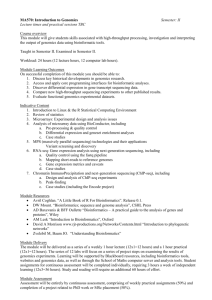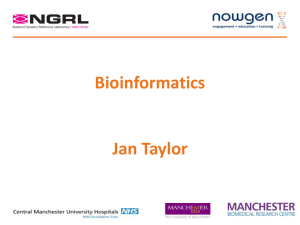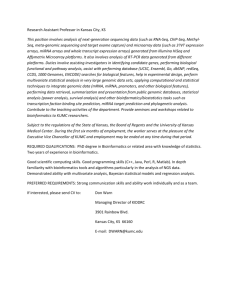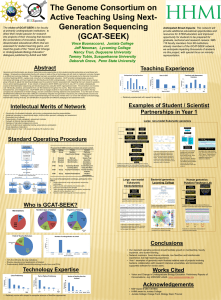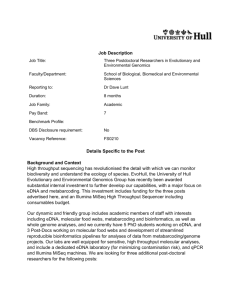Bioinformatics Basics II
advertisement
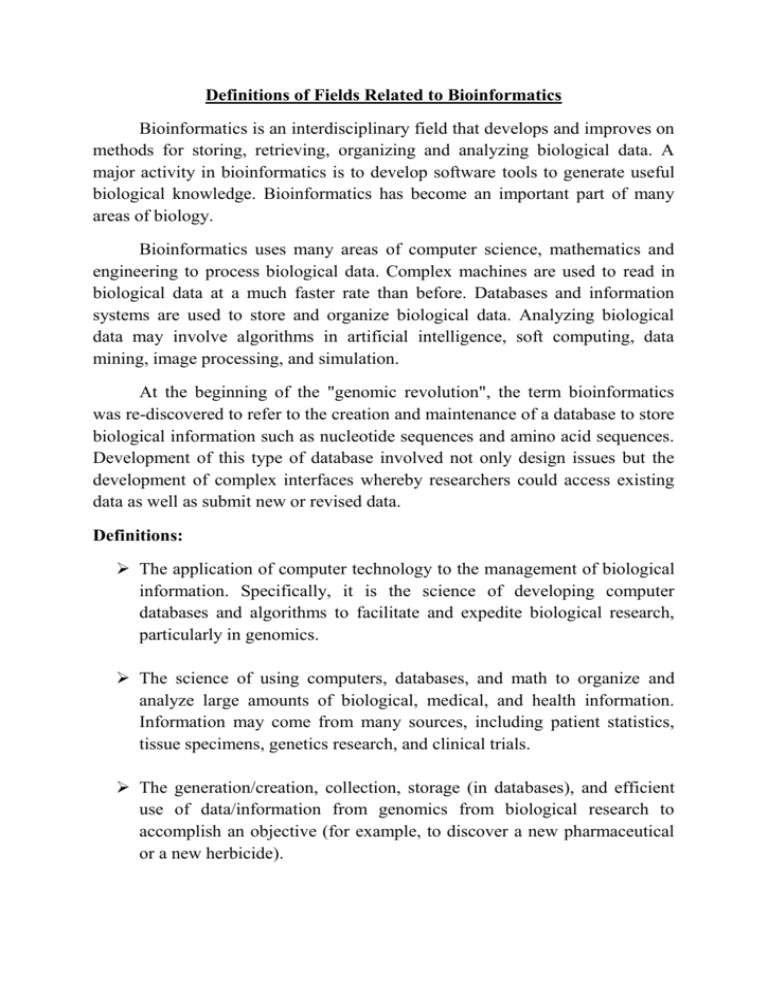
Definitions of Fields Related to Bioinformatics Bioinformatics is an interdisciplinary field that develops and improves on methods for storing, retrieving, organizing and analyzing biological data. A major activity in bioinformatics is to develop software tools to generate useful biological knowledge. Bioinformatics has become an important part of many areas of biology. Bioinformatics uses many areas of computer science, mathematics and engineering to process biological data. Complex machines are used to read in biological data at a much faster rate than before. Databases and information systems are used to store and organize biological data. Analyzing biological data may involve algorithms in artificial intelligence, soft computing, data mining, image processing, and simulation. At the beginning of the "genomic revolution", the term bioinformatics was re-discovered to refer to the creation and maintenance of a database to store biological information such as nucleotide sequences and amino acid sequences. Development of this type of database involved not only design issues but the development of complex interfaces whereby researchers could access existing data as well as submit new or revised data. Definitions: The application of computer technology to the management of biological information. Specifically, it is the science of developing computer databases and algorithms to facilitate and expedite biological research, particularly in genomics. The science of using computers, databases, and math to organize and analyze large amounts of biological, medical, and health information. Information may come from many sources, including patient statistics, tissue specimens, genetics research, and clinical trials. The generation/creation, collection, storage (in databases), and efficient use of data/information from genomics from biological research to accomplish an objective (for example, to discover a new pharmaceutical or a new herbicide). Research, development, or application of computational tools and approaches for expanding the use of biological, medical, behavioral or health data, including those to acquire, store, organize, archive, analyze, or visualize such data. Bioinformatics is closely related to computational biology. In experimental molecular biology, bioinformatics techniques such as image and signal processing allow extraction of useful results from large amounts of raw data. In the field of genetics and genomics, it aids in sequencing and annotating genomes and their observed mutations. It plays a role in the textual mining of biological literature and the development of biological and gene ontologies to organize and query biological data. It plays a role in the analysis of gene and protein expression and regulation. Bioinformatics tools aid in the comparison of genetic and genomic data and more generally in the understanding of evolutionary aspects of molecular biology. At a more integrative level, it helps analyze and catalogue the biological pathways and networks that are an important part of systems biology. In structural biology, it aids in the simulation and modeling of DNA, RNA, and protein structures as well as molecular interactions. Fields Related to Bioinformatics Genomics: The branch of molecular biology concerned with the structure, function, evolution, and mapping of genomes. It involves the ordering of genes in a haploid set of chromosomes of a particular organism; the full DNA sequence of an organism; "the human genome contains approximately three billion chemical base pairs" Proteomics: The branch of genetics that studies the full set of proteins encoded by a genome. It is the large-scale study of proteins, particularly their structures and functions. Proteins are vital parts of living organisms, as they are the main components of the physiological metabolic pathways of cells. The term proteomics was first coined in 1997 to make an analogy with genomics, the study of the genes. The word proteome is a blend of protein and genome, and was coined by Marc Wilkins in 1994 while working on the concept as a PhD student. The proteome is the entire complement of proteins, including the modifications made to a particular set of proteins, produced by an organism or system. This will vary with time and distinct requirements, or stresses, that a cell or organism undergoes. Proteomics is an interdisciplinary formed on the basis of the research and development of the Human Genome Project, is also an emerging scientific research and exploration of the proteome research from the overall level of intracellular protein composition, structure, and its own unique activity patterns. It is an important component of functional genomics. It is more complicated than genomics because an organism's genome is more or less constant, whereas the proteome differs from cell to cell and from time to time. Pharmacogenomics: The study of the interaction of an individual's genetic makeup and response to a drug. The identification and study of genes and their corresponding products that influence individual variation in the efficacy and toxicity of therapeutic products, and the application of genomic information to help inform therapeutic product development and clinical application. Pharmacogenomics extends the study of pharmacology to modern genetics. Knowing the full genetic complement of the human genome, the development and testing of drugs can be assessed at a global molecular level and can also take into account genetic differences between individuals, e.g., can assess the drug efficacy one patient at a time. Basing pharmacology on genomics thus will eventually allow to match drugs with patients that actually respond well to them, and avoid giving medication to patients that do not respond at all or have side effects. The field of science that studies how genetic inheritance affects the way that the body responds to medications. The science that examines the inherited variations in genes that dictate drug response and explores the ways these variations can be used to predict whether a patient will have a good response to a drug, a bad response to a drug, or no response at all. Pharmacogenetics: All individuals respond differently to drug treatments; some positively, others with little obvious change in their conditions and yet others with side effects or allergic reactions. Much of this variation is known to have a genetic basis. Pharmacogenetics is a subset of pharmacogenomics which uses genomic/bioinformatic methods to identify genomic correlates, for example SNPs (Single Nucleotide Polymorphisms), characteristic of particular patient response profiles and use those markers to inform the administration and development of therapies. Strikingly such approaches have been used to "resurrect" drugs thought previously to be ineffective, but subsequently found to work with in subset of patients or in optimizing the doses of chemotherapy for particular patients. Cheminformatics: The Web advertisement for Cambridge Healthtech Institute's Sixth Annual Cheminformatics conference describes the field thus: "the combination of chemical synthesis, biological screening, and data-mining approaches used toguide drug discovery and development" but this, again, sounds more like a field being identified by some of its most popular (and lucrative) activities, rather than by including all the diverse studies that come under its general heading. The story of one of the most successful drugs of all time, penicillin, seems bizarre, but the way we discover and develop drugs even now has similarities, being the result of chance, observation and a lot of slow, intensive chemistry. Until recently, drug design always seemed doomed to continue to be a labour-intensive, trial-and-error process. The possibility of using information technology, to planintelligently and to automate processes related to the chemical synthesis of possible therapeutic compounds is very exciting for chemists and biochemists. The rewards for bringing a drug tomarket more rapidly are huge, so naturally this is what a lot of cheminformatics works is about. The span of academic cheminformatics is wide and is exemplified by the interests of the cheminformatics groups at the Centre for Molecular and Biomolecular Informatics at the University of Nijmegen in the Netherlands. These interests include: · Synthesis Planning · Reaction and Structure Retrieval · 3-D Structure Retrieval · Modelling · Computational Chemistry· Visualisation Tools and Utilities Medical Informatics: "Biomedical Informatics is an emerging discipline that has been defined as the study, invention, and implementation of structuresand algorithms to improve communication, understanding and management of medical information." Medical informatics is more concerned with structures and algorithms for the manipulation of medical data, rather than with the data itself. This suggests that one difference between bioinformatics and medical informatics as disciplines lies with their approaches to the data; there are bioinformaticists interested in the theory behind the manipulation of that data and there are bioinformatics scientists concerned with the data itself and its biological implications. Medical informatics, for practical reasons, is more likely to deal withdata obtained at "grosser" biological levels---that is information from super-cellular systems, right up to the population level-while most bioinformatics is concerned with information about cellular and biomolecular structures and systems.


